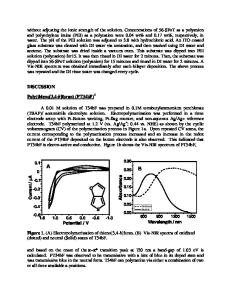New Nonlinear Optically Active Polymers Containing Hydrazone Chromophores
- PDF / 643,530 Bytes
- 12 Pages / 414.72 x 648 pts Page_size
- 30 Downloads / 304 Views
ethers), poly(amino ethers), or epoxy thermosets. We will describe the synthesis and NLO properties of these novel functional chromophores, and of the polymers based on these chromophores. H I R--(A)m (D)n-- R--C-- N- N-
RESULTS AND DISCUSSION General Preparation of Hydrazone Chromophores Polymerizable nonlinear optically active hydrazones were prepared in high yield by the acid-catalyzed condensation of substituted aryl hydrazines with hydroxy- or amino-functional ketones or aldehydes. The NLO active hydrazones are high melting solids that were generally recovered in 80-95% yields. In most cases, no extensive purification was required before polymerization. The preparation of compound 2 is shown as an example (Scheme 1). Scheme 1. Preparation of Polymerizable Hydrazone 2. NO2
NH
0N[Hf]
HO
OH
NH 2
HO
2
OH
Using this methodology, structural variations are readily introduced into the chromophore, and ultimately into the NLO-active polymers. Monomers have been prepared with nitro, dinitro, and tricyanovinyl electron withdrawing groups, in addition to hydroxyl or amino functionalities (Table I). With the exception of the tricyanovinyl-functional 4, hydrazones 2-7 have absorption maxima between 406 and 431 nm. Second-order hyperpolarizability (p43) measured for the compounds in solution by EFISH, shows significant resonance enhancement at 1064 nm, with values ranging from 2571 x 10-48 esu for 3, a bis-hydrazone, to 600 x 10 48 esu for 7, a hydrazone with both hydroxyl and amino functional groups. When measured at 1579 nm, the p43 values drop substantially, to 672 x 10-48 esu for 3, about one-half of that measured for DANS. Compound 4, with a strongly electron-withdrawing tricyanovinyl group, has a ,maxof 553 nm, and a p43 of 2440 x 10-48 esu when measured at 1579 nm. The amino-functional hydrazone 5, with amino groups located at the 4,4' positions, has a p43 of 1950 x 1048 esu, while p43 for 6 (substituted at the 3,3' positions) drops to 680 x 1048 esu. 54
No
Table I. Structures and Properties of Selected Polymerizable Hydrazones. Structure Yield (%) m.p. ('C) ,maxa ,03 10 64 b 04. 15 7 9b
.NH
2
1
90
245-247
415
827
455
191-193
418
2571
672
81
250-251
553
-
2440
H
86
219-221
n.a.
1226
n.a.
NNH
89
196-198
431
1950
400
91
202-205
406
680
-
OH
HN
HC N
INCH,
.NC.?94
3 HO
OH NC
C
N'
2
HOJýc
5
6
N
OH
H2NOH,
7
NNH H 2N -CJ
NH2
anrm bpp3 values measured in solution by EFISH at indicated wavelength (x 10-4 8esu).
4,4'-dimethylaminonitrostilbene (DANS): 11131064=2765 x 10-48 esu; 41131579=1271 x 10-4 8esu 55
Preparation of Hydrazone-Containing Polycarbonates Arylhydrazones with two hydroxyl groups were incorporated into polycarbonates by one of two methods (Scheme 2). In the first, a random copolycarbonate was generated by the reaction of a mixture of diphenols, one of which contained the hydrazone moiety, with phosgene in the presence of pyridine as a hydrohalide acceptor. Alternating copolycarbonates were prepared by the reaction of the bis-chloroformate of
Data Loading...










